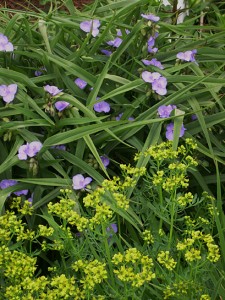
 Spiderwort (Tradescantia x andersoniana aka T. virginiana)
Spiderwort (Tradescantia x andersoniana aka T. virginiana)
The flowers are produced in terminal umbels. Flowers in each umbel open a few at a time and for only one day so the bloom period extends for a long time. The leaves are linear and get ratty after blooming ceases. Cut back to 8-12” and the foliage will quickly reappear often with flower bearing stems for a rebloom. When growing in favorable conditions, spiderwort can reseed.
-
Bloom Time: Late spring into early summer
Size: 1-2’ H x 3’ W-9
Hardiness: Zones 4
 Rue (Ruta graveolens)
Rue (Ruta graveolens)
Known from European monastery gardens in the Middle Ages for its herbal qualities, rue is considered a semi-shrub which means that it becomes woody at the base but dies down in winter. The small yellow flowers are delicate and borne in clusters. Many gardeners grow rue just for the foliage which is aromatic, finely divided and bluish-green. ‘Jackman’s Blue’ is an especially handsome cultivar with pale yellow flowers and glaucous blue foliage that has a cooling effect on hot colors such as red.
-
Bloom Time: Early summer
Size: 12-36” H x 30” W
Hardiness: Zones 4-9
